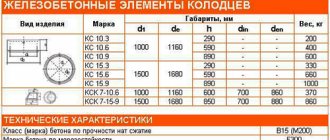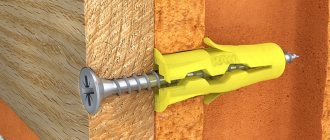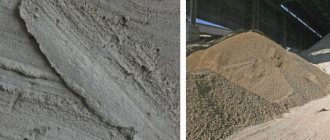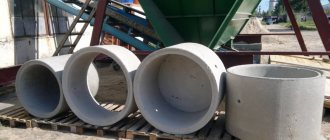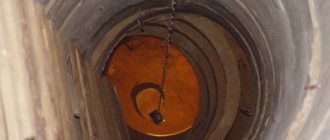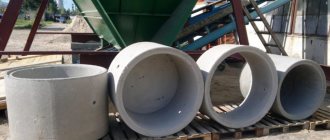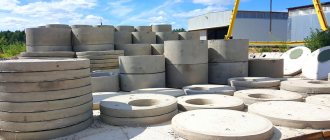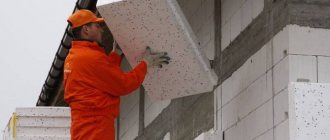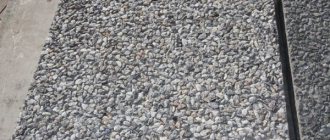Application and Description
The concrete cover of the well has a protective function, protecting the communication nodes from the effects of external aggressive environments, subsidence and landslides, blocking the access of unauthorized persons and other factors that may pose a threat of breakage or collapse.
The reinforced concrete product is made with a special technological hole into which the hatch is mounted . This solution facilitates access to the well shaft. A concrete cover is a typical flat-shaped product used in drainage, drainage and storm sewer systems. It acts as the final element of the structure and is installed after installing the well.
The disadvantages are the difficulty of organizing loading/unloading operations; high demands are placed on the production of products
Product advantages:
- the lid production method ensures a dense and uniform structure, which results in high strength;
- The products have a long period of safe operation. Provided the installation technology is followed, the finished structure will not be subject to corrosion, rotting, etc.;
- despite the impressive weight, installation is very simple;
- concrete is the material that does not spoil the properties of drinking water.
Advantages and disadvantages
A reinforced concrete well cover has the following positive properties:
- long service life. The durability of reinforced concrete covers is explained by manufacturing technology. High-quality raw materials are vibrocompressed, and the finished product is dried with hot steam. The finished design is highly reliable and durable. The installed cover can be used to lay road surfaces without the risk of subsidence or destruction;
- resistance to precipitation, ultraviolet radiation, frost, high temperatures and pests;
- resistance to rotting, fungus and mold;
- simplicity and ease, high speed of installation. The large mass of the products is not an obstacle to their quick installation, including with your own hands. On the other hand, the massiveness of the structure does not allow it to be accidentally moved, which increases the safety of the well’s operation;
- high environmental qualities. Reinforced concrete is non-toxic and safe for human health and the environment. Reinforced concrete covers can be used for water supply wells and come into contact with drinking water;
- a variety of types of covers (in shape, size, presence of holes, etc.) allows you to select a model for each well structure;
- durable protection of communications: the heavy weight of the cover minimizes the risk of its accidental displacement;
- the presence of sling loops.
The disadvantages of reinforced concrete covers of well structures include the following:
- price (from several thousand rubles);
- heavy weight, which determines the need to involve several people and special equipment for installation;
- low aesthetics;
- strict manufacturing technology - otherwise the lid may not be strong enough or difficulties may arise in making a hole in the lid.
Manufacturing techniques
Floor slabs for wells must be reinforced with steel spatial frames . The basis of the reinforcement is thermally strengthened carbon steel. It is permissible to use flat welded mesh made of hot-woven wire made using resistance spot welding. Any metal product is treated with special compounds that prevent the development of corrosion.
Materials
Concrete covers for wells are made on the basis of heavy concrete B15/B20. The grade of material in terms of compressive strength depends on the size of the product and scope of application.
Reinforced concrete products of this type are produced in accordance with GOST 8020 90, produced in batches according to the 3.900-3 series. and must meet the following requirements:
- to protect reinforcement from corrosion;
- by rigidity, actual strength (tempering and design strength), crack resistance;
- waterproof and frost-resistant;
- by grade of steel used for the production of embedded products and fittings;
- along the thickness of the protective concrete layer to the reinforcement.
Fittings:
- wire class ВрI;
- hot-woven rod classes AI, II, III;
- rod thermomechanically hardened steel At IIIC, IVC.
How to choose a well cover
When purchasing a reinforced concrete product, you should focus on the diameter of the well; the diameter of the cover should be identical or slightly larger. For the construction of the simplest structure for private use , a thickness of 10 cm is sufficient .
The grate can be made of wear-resistant cast iron or stainless steel - both products are characterized by long-term operation
The lid hole can be placed strictly in the center or offset to the side. As a rule, this parameter is not particularly important - the choice depends on the actual operating conditions. itself can be round or rectangular . A round recess improves the mechanical strength of the structure, a square one is most often used in the construction of sewer, drainage or stormwater systems; a drainage grate is inserted into it.
The design differences are revealed as follows:
- solid concrete floors are the simplest and most common option, which should be taken into account if the well is located outside the site; other modifications have holes for hatches;
- Regardless of the type of product, it can be made with smooth ends or with a figured fold (joint type). Covers with a quarter are designed for mounting on a locking ring and are marked with the letter “C”;
- Manufacturers produce slabs with an installed hatch, which increases the cost of the product.
Existing types
Varieties of reinforced concrete covers for wells differ in shape, type of ends and the presence or absence of holes.
Cover shape
The shape of the cover is determined by its functional purpose and the shape of the shaft. She may be:
- square;
- rectangular;
- round.
The ends of the cover are:
- smooth;
- with a quarter: the cover is provided with grooves and projections to facilitate installation on a ring with a locking connection. The rebated profile under the lower part of the ring is intended for installing a drainage grid.
Presence of holes
Based on the presence of holes, the following cover models are distinguished:
- deaf;
- with a through hole, located in the center or offset from the center (more convenient for servicing the well);
- with two holes (most often used for constructing cesspools and septic tanks).
The shape of the holes on the lid can be:
- round (increase the strength of the product);
- rectangular;
- square (suitable for installing drainage grates in sewerage systems).
ATTENTION! The diameter of the round hole must be at least 0.7 m to allow access for maintenance by a technician. If the lid is square, the length of its sides should also not be less than 70 cm.
IMPORTANT! The shape of the cover hole can be changed using a diamond grinding wheel.
Installation
The reinforced concrete element is installed after the well is completely assembled. When choosing a cover, you should focus on the standard sizes and diameter of the rings that form the shaft. For installation work, manual labor or special lifting mechanisms are used.
To make the system airtight, the slab is installed on cement mortar . During the work process, you need to monitor the position of the hole - it must be strictly above the brackets. The joints are treated with a primer; if there is a fold, a hemp rope is placed in it. All seams are sealed .
The final stage is the installation of a hatch, which complements the protection of the internal space of the well from penetration and ensures safe operation.
Concrete products for wells
The concrete cover can be called universal; it is suitable both for concrete country wells and for laying gas pipelines and network systems in industrial construction.
- not afraid of frost;
- the strength indicator is high;
- long service life;
- water will not get inside the tank through such an overlap.
Kawabanga! Why are reinforced concrete floor beams needed?
Choice
Concrete set
When choosing this product you need to pay attention to the following points:
What to consider during installation?
Making a concrete cover for a well with your own hands does not require as much time and effort as it might seem at first glance.
For this you will need:
- concrete solution;
- reinforcing mesh;
- the form in which the mortar with reinforcing mesh will need to be laid.
Manufacturing technology
Most often, concrete well rings are covered with a concrete cover. It can be either in the form of a hatch with a hole, or in the form of a solid slab. As an example, let’s consider the technology for manufacturing a concrete product with a hatch that will have the shape of a square.
How much does a concrete product for covering a sewer well weigh?
To protect sewer shafts from contamination, a concrete hatch is used. As a rule, for such wells a lid weighing from fifty kilograms is used.
Types and weight of hatches:
- the weight of the sidewalk hatch is within five tons;
- the weight of a “light” reaches a maximum of fifteen tons;
- the weight of “heavy” ones reaches twenty tons.
In order to understand which lid you should choose, you need to familiarize yourself with other types of lids.
Marking
- floor slabs for water intake wells 1PP8, 2PP8;
- slab well - KCP;
- floor slabs for wells of gas, sewer and water supply networks PP10, PP13, 1PP15, 2PP15, 3PP15, 1PP20, 2PP20, 3PP20, 1PP25, 2PP25.
Concrete covers are transported using special transport, the products are placed in layers, which are laid over with plank material
Concrete covers for wells dimensions
| Reinforced concrete well covers, dimensions | |||
| Standard size | Internal diameter, mm | External diameter, mm | Height, mm |
| 1PP8 | 580.0 | 1000.0 | 170.0 |
| 2PP8 | 800.0 | Same | Same |
| PP10 | 700.00 | 1160.0 | 150.0 |
| PP13 | Same | 1410.0 | Same |
| 1PP15 | Same | 1680.0 | Same |
| 2PP15 | Same | Same | Same |
| 3PP15 | 1000.0 | Same | Same |
| 1PP20 | 700.0 | 2200.0 | 160.0 |
| 2PP20 | 1000.0 | Same | Same |
| 3PP20 | 700.0 | Same | Same |
| 1PP25 | Same | 2700.0 | 180.0 |
| 2PP25 | Same | Same | Same |
Well hatch
The shape of a concrete hatch for wells is in most cases standard - round, with an average diameter of 70 cm . If necessary, a lid with a square hatch is installed, which is typical for wells with a collar.
Installation of such products is a mandatory condition of operation; proper installation of utility networks in a private home is impossible without them. The use of manholes without neck insulation is prohibited . Hatches are used for arranging drainage systems, storm drains, and sewer systems.
Structurally, the product consists of a shell (rim), which is mounted on the neck of the lid, which protects the structure from external factors.
The following hatches are intended for private use:
- cast iron - SCh20. Installing such a durable and massive model is only advisable if the well will be subject to loads from passing vehicles;
- polymer - these are lightweight, durable and functional products, available at low cost in various colors - the most effective option for your own site;
- concrete - most often used to seal a septic tank, with non-standard dimensions of inspection wells, based on a specific project.
The range of lids is not so large that it is impossible to do it yourself
Hatches with lock
In private homes, such devices protect the system from accidental opening.
The simplest and most reliable locking connections are:
- spacer mechanisms;
- threaded;
- flag.
Product characteristics are indicated in the tabular data.
| Load class | Name | Full opening, D, mm | Load, kN | Weight, kg | Installation depth, mm |
| ST | Hatch extra heavy | 550.00 | 600.0 | 155.0 | 60.0 |
| TM | Trunk heavy | 400.0 | 140.0 | 50.0 | |
| T | Heavy | 250.0 | 120.0 | 35.0 | |
| WITH | Average | 125.0 | 95.0 | 25.0 | |
| LM | Easy | 15.0 | 60.0 | 20.00 | |
| LM | Lightweight and compact | 450.0 | 45.0 |
Plastic lids
Plastic product
As for this type of roof, it is always suitable. The advantages of such a product include:
- low cost;
- light weight;
- high heat resistance;
- huge selection of colors;
- quick and easy installation;
- service life is on average 25 years;
- such a device can withstand a load of 200 kg.
Installation requires plastic/metal fasteners.
How to make it yourself
Independent production of reinforced concrete products will allow you to save on the purchase of ready-made structures.
The manufacturing process of a lid with a square hole of 70x70 cm follows the following principles:
- before construction, all materials must be prepared: formwork board, polyethylene film, M200 concrete, reinforcement stack;
- in a free area, dig a trench 10 cm deep, its diameter must coincide with the diameter of the wall ring of the well;
- formwork is installed in the center under the hole for the hatch;
- a square structure consisting of four boards with sides of 70 cm should fit in the center;
- the bottom and walls of the formwork are covered with polyethylene;
- the first layer of concrete is poured - 5.00 cm;
- lay reinforcement mesh;
- the second layer is poured - 5.00 cm.
Cover with metal frame
There are ready-made plugs on sale, made entirely of metal, but due to their heavy weight (at least 25 kg), private drinking wells are rarely covered with them.
You can use a metal corner to make the frame of the lid. The parts are welded together, coated with anti-corrosion primer and enamel or paint (there are compounds that additionally protect against rust). The frame can be covered with wood or textolite.
On the left is a metal cover with a hatch, on the right is a concrete cover with a metal hatch.
Concrete cover for a well, price
When the material reaches the specified strength, the product is used for its intended purpose. If the structure will be used in winter, it must be insulated.
If you need to purchase ready-made concrete covers for wells, the retail price is 1150 rubles and above . It is cheaper to make the product yourself; such an approach is advisable if the structure will not experience high loads and is intended exclusively for private use.
When constructing wells, you can use ready-made reinforced concrete products or those made by yourself. If you follow the technological process, independent production is more profitable from an economic point of view.
Making a concrete cover for a well with your own hands is shown in the video:
Cast iron lids
Cast iron hatch
It is worth noting that a cover for a sewer well made of concrete with a built-in cast iron hatch is excellent protection against the entry of various types of contaminants. Its service life reaches ten years. Its advantage is that it does not rust and has a high strength index.
Note : As for weight, it can weigh much less than concrete. The thickness reaches two millimeters. In order for it to be opened at the top, a handle is made.
To make it you will need:
- cast iron sheet;
- fittings;
- welding machine (needed to weld the handle);
- to cut metal you will need a grinder;
- putty will be needed to fill the flaws;
- solvent (it is necessary for wiping the product before painting);
- primer and paint.
It is worth noting that there can be any number of welded handles. For originality, you can weld forged elements.
Making a lid from metal corners at home
To work you will need:
- corners;
- welding machine and grinder;
- tape measure, pipes;
- loops;
- textolite;
- sealant, insulation material;
- dye.
Process:
- Creating a sheathing. Metal corners are cut into four parts at an angle of 45 degrees. We connect the segments so that the result is a square. We weld.
- After the pipes are cut, they are placed in the sheathing. Welded.
- The plates cut to size are attached to the PCB lathing. A sealant is placed into the resulting cracks. The seams are treated with sealant.
- The roof is attached to the sheathing.
- Creation of formwork. Pouring with concrete mixture.
- Fastening the formwork.
- Attach the handles.
